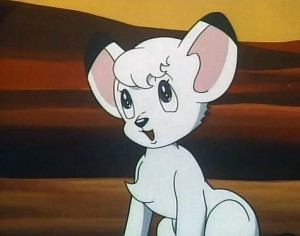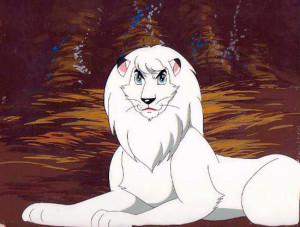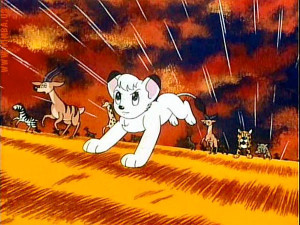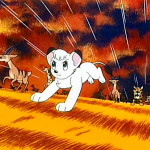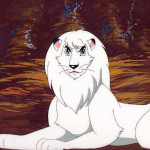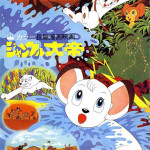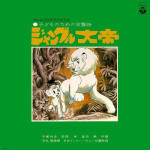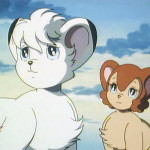Jungle Emperor [aka Kimba] (Anime)
Also known as ジャングル大帝 (Junguru Taitei)
There are several animated versions of Jungle Emperor. Although the most famous is the original 1965-66 television series, the list also includes the 1966 theatrical movie, the 1966-67 television sequel, Jungle Emperor: Onward, Leo!, the Symphonic Poem, the 1989 television series, New Jungle Emperor, the 1997 theatrical movie, Jungle Emperor Leo, and the 2009 television special, Jungle Emperor: The Brave Can Change the Future.
What it’s about
Jungle Emperor tells the story of a white lion cub named Leo. Set in Africa in the mid–20th century, the story opens with Leo’s father, Panja having established a safe haven for the other animals in his jungle kingdom, free from fear of each other. However, Panja runs afoul of nearby human villages as he raids them in search of pigs, cattle and other domesticated animals to feed his animal subjects. The villages call in a professional hunter to stop the raids and eventually Panja is killed and his pregnant mate is captured. Born into captivity, Leo (with the help of his mother) escapes and is eventually taken in by kindly humans far from home. Learning the benefits of human culture, Leo decides to return to Africa and expand his father’s peaceful animal kingdom with what he has learned.
What you should know
In late 1964 the American television giant National Broadcasting Company (NBC), looking to follow up on the success of the original 1963 black & white Astro Boy animated television series, approached Osamu Tezuka with a request for a new program. Although they were happy with Tezuka’s pitch for a serial following the adventures of a heroic white lion, this time around they were adamant the series had to be produced in colour. So adamant in fact that, since Tezuka’s Mushi Productions did not yet have the capability of colour production, NBC agreed to finance the necessary upgrades.
Although Tezuka’s original series proposal mirrored the manga’s overall story quite closely, several major accommodations were made given that Jungle Emperor was being produced for both domestic (Japanese) and overseas (USA) markets at the the same time. The first of these was an almost complete ban on violence, especially bloody violence and death. Also, the very idea that the series star (i.e. Leo) would die in the final episode was a concept completely foreign to American audiences at the time. Given these constraints, NBC felt it was much better to concentrate simply on Leo’s adventures as a young cub. In this way the young audience would identify better with the main character, while at the same time it would also make it easier for local television stations (the lifeblood of network television) to air the episodes out of sequence.
Although this significantly changed the premise of Jungle Emperor from the life-story of a white lion trying to establish an animal civilization to merely a set of episodic (and somewhat disjointed) adventures of a white lion cub, Tezuka agreed based on a promise from NBC to continue the series Tezuka’s way should the first series turn out to be a success.
And so, despite some early production challenges, Jungle Emperor debuted on Fuji TV on October 6, 1965 and completed a very successful run of all 52 episodes on September 28, 1966. Usually considered Japan’s first full-colour animated television series, it was beaten to the punch six months earlier by a three-episode (and largely forgotten) television program called Prince Dolphin. However, given the difference in scope (52 weekly episodes vs. 3 one-offs), Jungle Emperor deserves its distinction.
So successful was the television series, that in July 1966 a theatrical movie was released in Japan. Although made up primarily of re-edited material from the television series, it does include short connecting scenes of all-new animation.
Since new episodes of Jungle Emperor were usually broadcast roughly a week after they were completed, the decision was made to wait until they were all completed before they were sent to NBC for re-dubbing and editing. And so, the newly retitled Kimba the White Lion premiered on American television in late 1966/early 1967 – the beginning of a long and successful run on NBC and in syndication.
Jungle Emperor was such a hit in Japan that Osamu Tezuka felt emboldened enough to charge ahead and invest his profits back into the sequel. Premiering on October 5, 1966 (the very next week after the end of the original series!), Jungle Emperor: Onward, Leo! began a second 26-episode run that ended on March 29, 1967. Relying on NBC’s promise to continue the series as Tezuka wanted, Onward, Leo! was set roughly five years after the events in the original series. Leo and Lyre were now fully adult and married, and early in the series their children Lune and Lukio were born.
However, Tezuka’s ambitious plan backfired on him – by not consulting NBC (so as to avoid further tampering), Tezuka felt free to move the series back towards its initial intent. However, this drastic change of course created a general disconnect between the two series – one that left audiences cold. So while Onward, Leo! was well-received, it was not as popular as the original. More seriously, NBC had not even known that Tezuka was working on the sequel until he presented it to them as a complete package. Unsurprisingly, the new series contained too many changes for NBC’s tastes – many of which they had specifically told Tezuka only a year or so earlier they did not want – and they declined to purchase the series. In NBC’s opinion, the new series was not a continuation of the original series but rather his original Jungle Emperor proposal, however in Tezuka’s eyes this was a betrayal and effectively ended his working relationship with NBC.
This, among other bad business deals, put Mushi Productions into financial difficulty, and it ultimately went bankrupt in 1973 – with Osamu Tezuka losing the rights to the television programs Mushi Productions had created, including Jungle Emperor and Jungle Emperor: Onward, Leo!. However, Tezuka did retain the rights to his characters and the rights to feature them in any new programs. So, after starting a new company called Tezuka Productions in the late 1970’s, Tezuka produced a new full-colour animated Astro Boy series in 1980. In 1988, shortly before his death on February 9, 1989, Tezuka Productions began work on a new animated television series. New Jungle Emperor began its own 52-episode run on October 12, 1989 and finished on October 11, 1990. In many ways New Jungle Emperor is a hybrid of the first two animated series: focusing on Leo as a young cub as in the original Jungle Emperor show, but exploring many of the violent and grim themes of Jungle Emperor: Onward, Leo!.
In 1997, Tezuka Productions released a full-blown theatrical animated feature called Jungle Emperor Leo. Directed and written by Yoshio Takeuchi, the movie is relatively faithful to the original manga story. Beginning just after the birth of Leo’s children, the movie finally completes the second half of Tezuka’s original manga story, culminating in the climactic events on Mt. Moon.
As part of the celebration of what would’ve been Osamu Tezuka’s 80th birthday, Tezuka Productions released and all-new Jungle Emperor television special. Airing on the Fuji Network on September 5, 2009, the TV movie, directed by Taniguchi Goro and entitled Jungle Emperor: The Brave Can Change the Future, made significant changes to the story in an attempt to update it for modern audiences. In this new version of the story, given rampant environmental concerns a private company called “Eternal Earth” creates an artificial jungle nature preserve and forces wild animals to live in it for their protection. Although this is a significant departure from his original vision, given his penchant for updating his stories in order to remain “current” one suspects Tezuka would have been pleased with the results.

